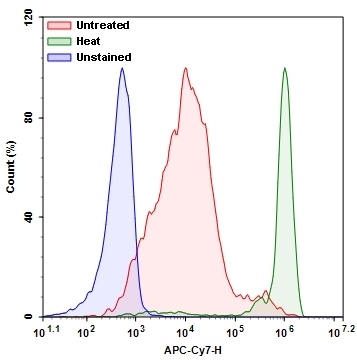Live or Dead™ Fixable Dead Cell Staining Kit
NIR Fluorescence
Our Live or Dead™ Fixable Dead Cell Staining Kits are a set of tools for labeling cells for fluorescence microscopic investigations of cellular functions. The effective labeling of cells provides a powerful method for studying cellular events in a spatial and temporal context. This particular kit is designed to uniformly label fixed mammalian cells in infrared fluorescence for flow cytometry applications with red laser excitation. The kit uses a proprietary red fluorescent dye that is more fluorescent upon binding to cellular components. The fluorescent dye used in the kit is well excited with the red (635 nm) to fluorescence at 775 nm (APC/CY7 channel). The kit provides all the essential components with an optimized cell-labeling protocol. It is an excellent tool for preserving of fluorescent images of particular cells, and can also be used for fluorescence flow cytometry applications.


| Catalog | Size | Price | Quantity |
|---|---|---|---|
| 22605 | 200 Tests | Price |
Spectral properties
| Excitation (nm) | 757 |
| Emission (nm) | 779 |
Storage, safety and handling
| H-phrase | H303, H313, H333 |
| Hazard symbol | XN |
| Intended use | Research Use Only (RUO) |
| R-phrase | R20, R21, R22 |
| UNSPSC | 12352200 |
Instrument settings
| Flow cytometer | |
| Excitation | 640 nm laser |
| Emission | 780/60 nm filter |
| Instrument specification(s) | APC-Cy7 channel |
| Fluorescence microscope | |
| Excitation | 749 nm |
| Emission | 775 nm |
| Recommended plate | Black wall/clear bottom |
Contact us
| Telephone | |
| Fax | |
| sales@aatbio.com | |
| International | See distributors |
| Bulk request | Inquire |
| Custom size | Inquire |
| Technical Support | Contact us |
| Request quotation | Request |
| Purchase order | Send to sales@aatbio.com |
| Shipping | Standard overnight for United States, inquire for international |
Page updated on December 9, 2025

